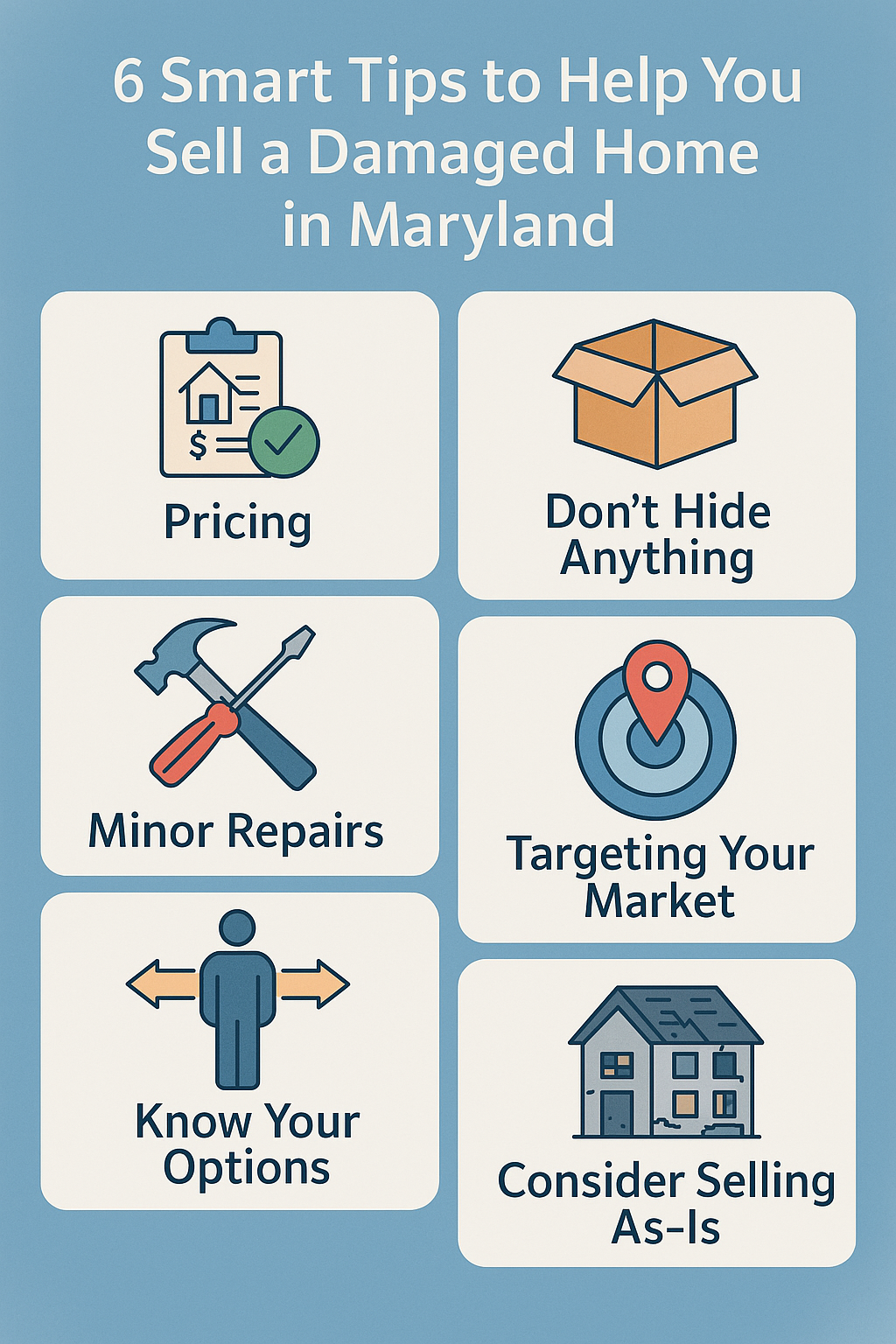
A damaged home in Maryland can feel like a heavy burden to carry. Whether it’s storm damage, fire issues, structural concerns, or years of deferred maintenance, putting such a property on the market can be overwhelming. Most buyers want a house they can move into immediately without dealing with expensive fixes, inspections, or lengthy renovation projects. When visible damage shows up in listing photos or during walk-throughs, buyers either walk away quickly or submit lowball offers that leave sellers frustrated and discouraged.
This situation becomes even more challenging the longer your house sits on the market. In Maryland’s competitive real estate landscape, a stale listing often signals to buyers that something is wrong, which typically leads to reduced offers over time. For a seller, that means you could end up accepting far less than you originally hoped for, all while juggling repair costs, holding expenses like taxes and insurance, and the emotional toll of waiting.
But here’s the good news: selling a home with damage doesn’t mean you’re stuck. You have options that can help you avoid the stress of endless negotiations and repairs while still getting a fair return. Many Maryland homeowners facing these obstacles have found relief by exploring alternative selling methods—like working with direct cash buyers who specialize in purchasing homes as-is. Instead of worrying about whether buyers will balk at mold, foundation issues, or a leaking roof, these professionals see the value and potential of the property beyond its current condition.
If your goal is to simplify the sales process, avoid sinking thousands into repairs, and maximize what you walk away with, you don’t have to follow the traditional route. In this article, we’ll explore six smart, practical tips that can make selling a damaged home in Maryland faster, less stressful, and ultimately more profitable.
1. Pricing Your Damaged Maryland Home Correctly
Correct pricing is one of the most important factors when selling a damaged home. If you price too high, buyers will overlook your listing. Price too low, and you risk losing tens of thousands of dollars in equity. Many sellers mistakenly rely on generic online calculators that don’t factor in property condition, but damaged homes need a more nuanced valuation.
Professional buyers like Simple Homebuyers are invaluable here. Unlike agents who often focus on retail-ready properties, professional buyers know the Maryland market and understand how to evaluate homes that require repairs. They assess both the local demand and the potential costs of renovation, giving you a realistic offer that reflects true market value.
For example, if similar homes in your neighborhood are selling at $350,000 but your property has $50,000 worth of structural and cosmetic issues, a professional buyer will account for those repairs in their offer while still aiming to keep it competitive. This honest approach avoids the “list high, slash later” cycle that often plagues traditional sales.
You can also consult resources like Realtor.com to research current Maryland housing trends. Combining professional guidance with your own research gives you the confidence to set a price that will attract serious buyers and lead to a faster sale.
2. Don’t Hide Anything – Full Disclosure Builds Trust
It might be tempting to gloss over the extent of damage when listing your home, but failing to disclose problems can have serious consequences. Maryland law requires sellers to disclose known defects, and buyers who later discover hidden problems can sue for damages. Beyond legal risks, hiding issues erodes trust and can make buyers pull out of deals.
Professional buyers at Simple Homebuyers work differently. They expect homes to have damage and won’t walk away because of it. Instead, they’ll partner with contractors and inspectors to assess what repairs are needed and give you an offer based on real numbers. This process not only saves you from surprise renegotiations later but also ensures that you feel confident about the fairness of the deal.
Being upfront about your home’s condition—whether it’s water intrusion, foundation cracks, or mold—also filters your buyer pool to those genuinely interested in as-is properties. While this may reduce the number of potential buyers, it increases the quality of offers and decreases wasted time.
The HUD Housing Guide recommends that sellers educate themselves on disclosure obligations and ensure contracts are transparent (HUD.gov). By working with professionals who practice transparency, you protect yourself legally and maintain credibility in the sales process.
3. Minor Repairs Can Make a Big Difference
While you may not want to pour thousands of dollars into renovations, small, affordable improvements can make your Maryland home more attractive to buyers. Think cosmetic upgrades—fresh paint, fixing broken fixtures, patching drywall, or tidying up the yard. These “quick wins” create better first impressions and can boost perceived value significantly.
For example, a damaged home with peeling paint and broken door handles will feel neglected, while a fresh coat of paint and minor fixes can reassure buyers that the property still has potential. Professional buyers like Simple Homebuyers can advise you on which repairs are worth the investment and which should be left for the next owner.
The goal is not to hide damage but to present your home in the best possible light. If a property looks well-kept, buyers are more likely to make serious offers. Even if you plan to sell as-is, a little effort in curb appeal can reduce lowball offers and help the property sell faster.
Check out HGTV’s guide on affordable home updates for simple, cost-effective repair ideas. When combined with an as-is cash sale, these minor efforts can maximize your return without requiring a massive outlay.
4. Targeting the Right Buyers in Maryland
Not every buyer is looking for a fixer-upper. Traditional homebuyers typically seek properties they can move into right away, which makes damaged homes less appealing. To sell efficiently, you need to target buyers who specialize in as-is homes.
Cash buyers, including investors and professional homebuyers, are the ideal audience. They aren’t deterred by structural issues or outdated interiors because they have the resources to repair and resell the property. Unlike traditional buyers, they don’t need financing approval, which means no bank delays or failed mortgage approvals.
Professional buyers at Simple Homebuyers focus specifically on homes in need of repair. They purchase properties directly from homeowners, saving you from lengthy listing periods, open houses, and costly staging. For Maryland homeowners, this means you can bypass months of stress and close the deal on your timeline.
By aligning your property with the right audience, you save time and eliminate the frustration of entertaining buyers who were never serious contenders. Instead of hoping a retail buyer will take a chance, you focus on those already equipped to handle a damaged home.
5. Know Your Options Before You Decide
Selling a damaged home in Maryland doesn’t mean you’re boxed into one path. In fact, homeowners have multiple options: list traditionally, make repairs and renovate, or sell directly to a cash buyer. Each path has its pros and cons.
If you have time, money, and emotional bandwidth, tackling repairs may allow you to list at a higher price. But this route also comes with risk—renovations can uncover hidden issues, and holding costs (taxes, insurance, mortgage) continue to add up while your home sits on the market.
Alternatively, selling to a direct buyer like Simple Homebuyers eliminates these challenges. You get a cash offer without spending another dime on repairs, commissions, or closing costs. For many Maryland homeowners facing financial strain, foreclosure, or urgent relocation, this option provides immediate relief.
The key is to carefully evaluate your circumstances and weigh the potential profit of each approach. Professional buyers will often help you compare outcomes honestly, even if it means recommending a traditional listing over a direct sale. That kind of transparency allows you to make an informed decision without pressure.
6. The Benefits of a Direct Sale to Simple Homebuyers
Ultimately, one of the smartest ways to sell a damaged home in Maryland is through a direct cash sale. At Simple Homebuyers, professional buyers provide an efficient process designed to reduce stress for homeowners. You don’t need to pay commissions or closing costs, and you don’t have to wait months for the right buyer to come along.
With a direct sale, you choose the closing date. That flexibility is crucial if you need more time to relocate or, conversely, want to close as quickly as possible. Because Simple Homebuyers uses cash, you don’t face the risk of deals falling apart due to financing.
In addition, Simple Homebuyers takes care of repairs after purchase. That means you’re not responsible for handling contractors, pulling permits, or budgeting for expensive fixes. For many homeowners, that peace of mind is worth as much as the financial benefit.
If you’re ready to explore this option, give Simple Homebuyers a call at (240) 776-2887. You’ll receive a no-obligation offer and a transparent breakdown of how it was calculated, so you can feel confident in your decision.
The Smartest Path Forward
Selling a damaged home in Maryland doesn’t have to be overwhelming or financially draining. While traditional listings often come with months of waiting, expensive repair bills, and the stress of open houses, you have alternatives that can save you both time and money. By pricing your home correctly, being transparent about its condition, considering minor improvements, and targeting the right buyers, you can position yourself for success even with a property that needs work.
Ultimately, a direct sale to a professional homebuyer like Simple Homebuyers is the most stress-free and financially sound option for many Maryland homeowners. With no commissions, no hidden fees, and the ability to sell your house “as-is,” you can walk away with cash in your hand and peace of mind. Whether you’re facing foreclosure, relocating, or simply don’t want the hassle of repairs, our team provides a fast, fair, and transparent solution that puts you back in control of your future.
If you’re ready to explore your options, give Simple Homebuyers a call at (240) 776-2887 or visit our website today. Selling a damaged home may seem challenging, but with the right partner, the process can be smooth, profitable, and even empowering.
